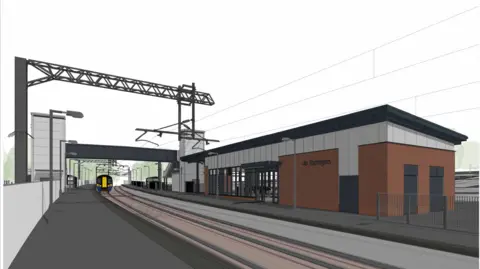Major rail line to close for 16 weeks
 Network Rail
Network RailThe railway between East Kilbride and Glasgow will be closed for four months from the end of January as part of a £140m project to electrify the line, Network Rail has announced.
New stations will also be built at East Kilbride and Hairmyres.
The project, delivered by Network Rail and part of a Scottish government investment, aims to decarbonise rail services and enhance reliability for passengers.
Work is expected to be fully complete by December 2025.
 Network Rail
Network RailThe new Hairmyres station will feature two platforms and an accessible footbridge, as seen in artist impressions.
New footbridges will also be constructed at Busby station and Giffnock, while Clarkston will have a new station entrance.
No trains will run on the line between East Kilbride and Thornliebank stations between 25 January and 18 May while work is carried out on the track, bridges and overhead line equipment along the route.
During this period, 22km of overhead power cables will be installed and the double-track between East Kilbride and Hairmyres will be extended.
Near Busby, Clarkston and Giffnock stations, the existing rack will lowered to accommodate overhead line equipment under some bridges.
 Network Rail
Network RailGerry McQuade, Network Rail capital delivery director, said: “This programme of extended engineering works is a critical point in the delivery of the electrification of the East Kilbride line.
“Closing the railway is never an easy decision, but the engineering work taking place over these 16 weeks can only be done when no trains are running.
"This approach allows the completion of these major works in the most efficient, fastest way."
Mr McQuade said he appreciated the impact the closure would have on those living closest to the line and passengers.
"We hope that by advising people three months ahead of the work starting, this raises awareness and allows people the time to consider alternative travel arrangements," he said.
Passengers are advised to check the ScotRail or National Rail websites in the coming weeks for information on the replacement bus service and to plan their journeys accordingly.
